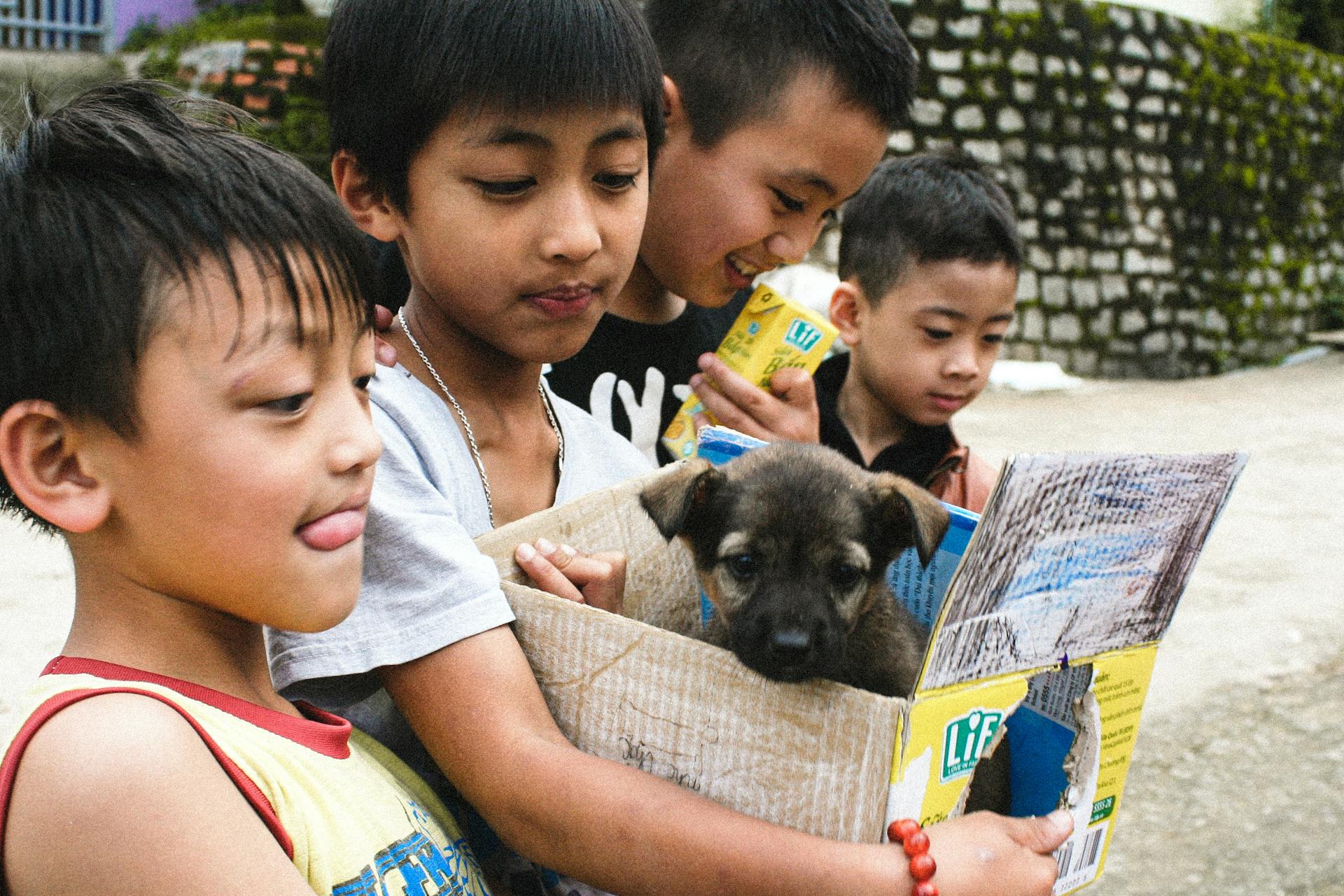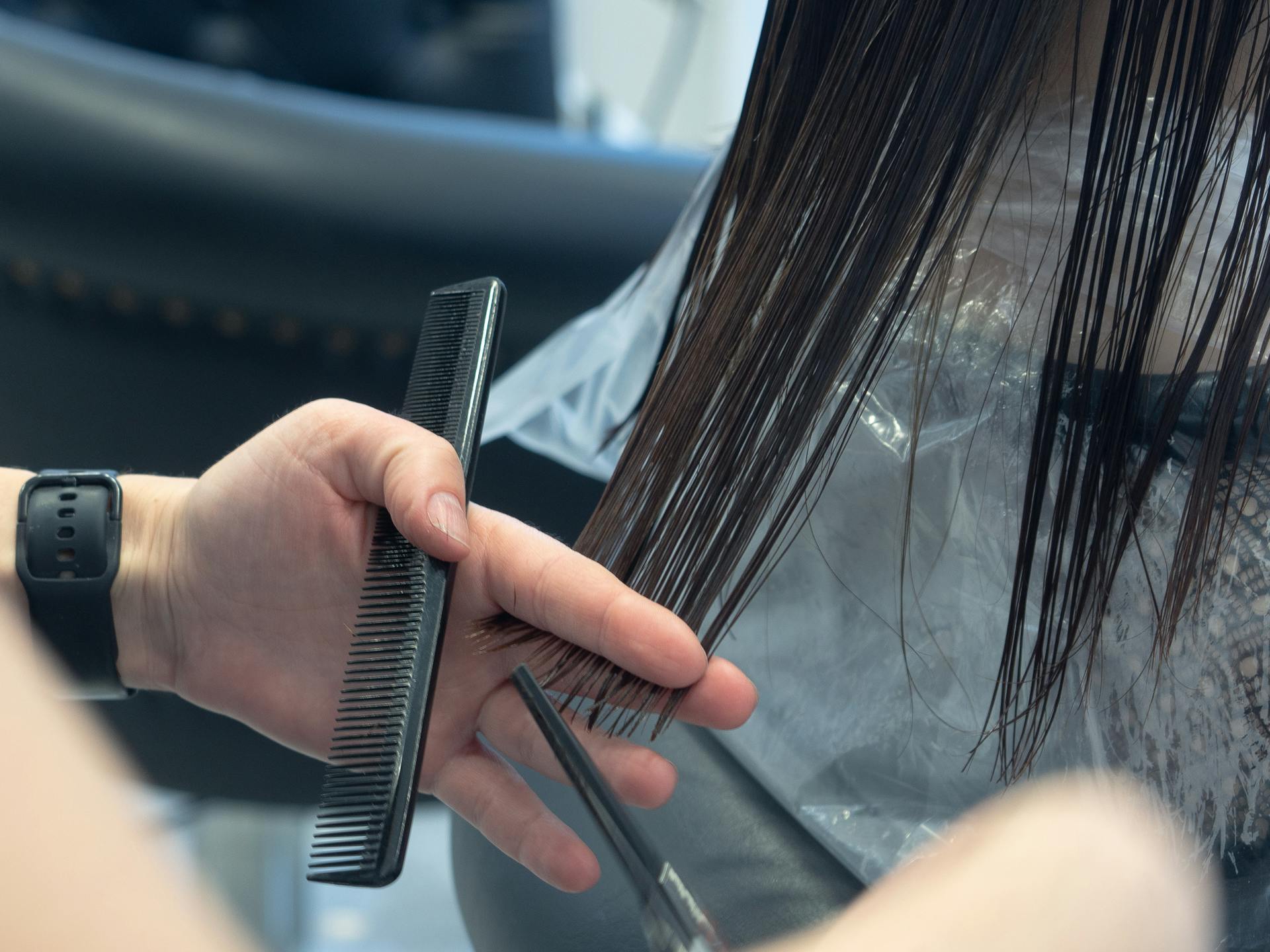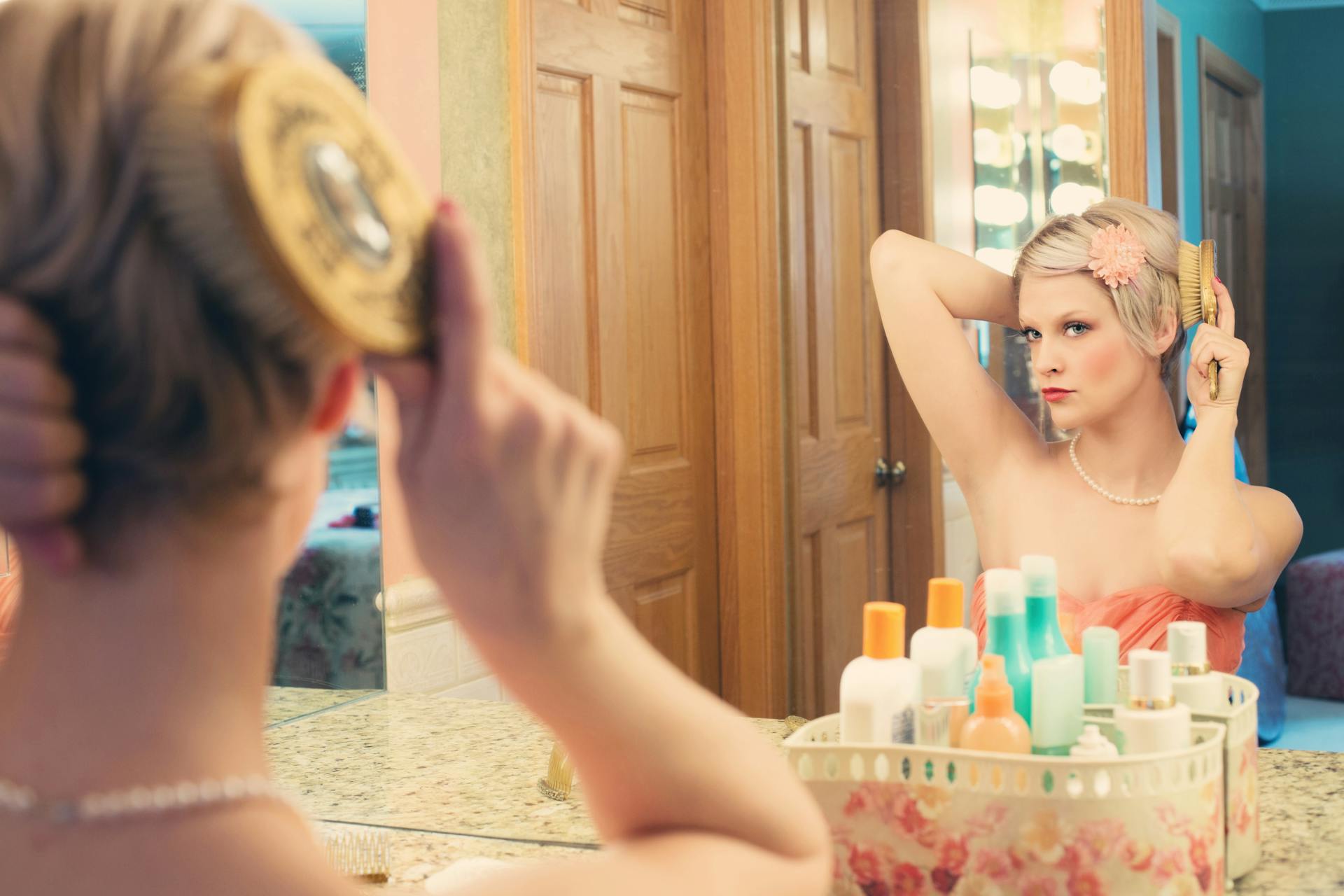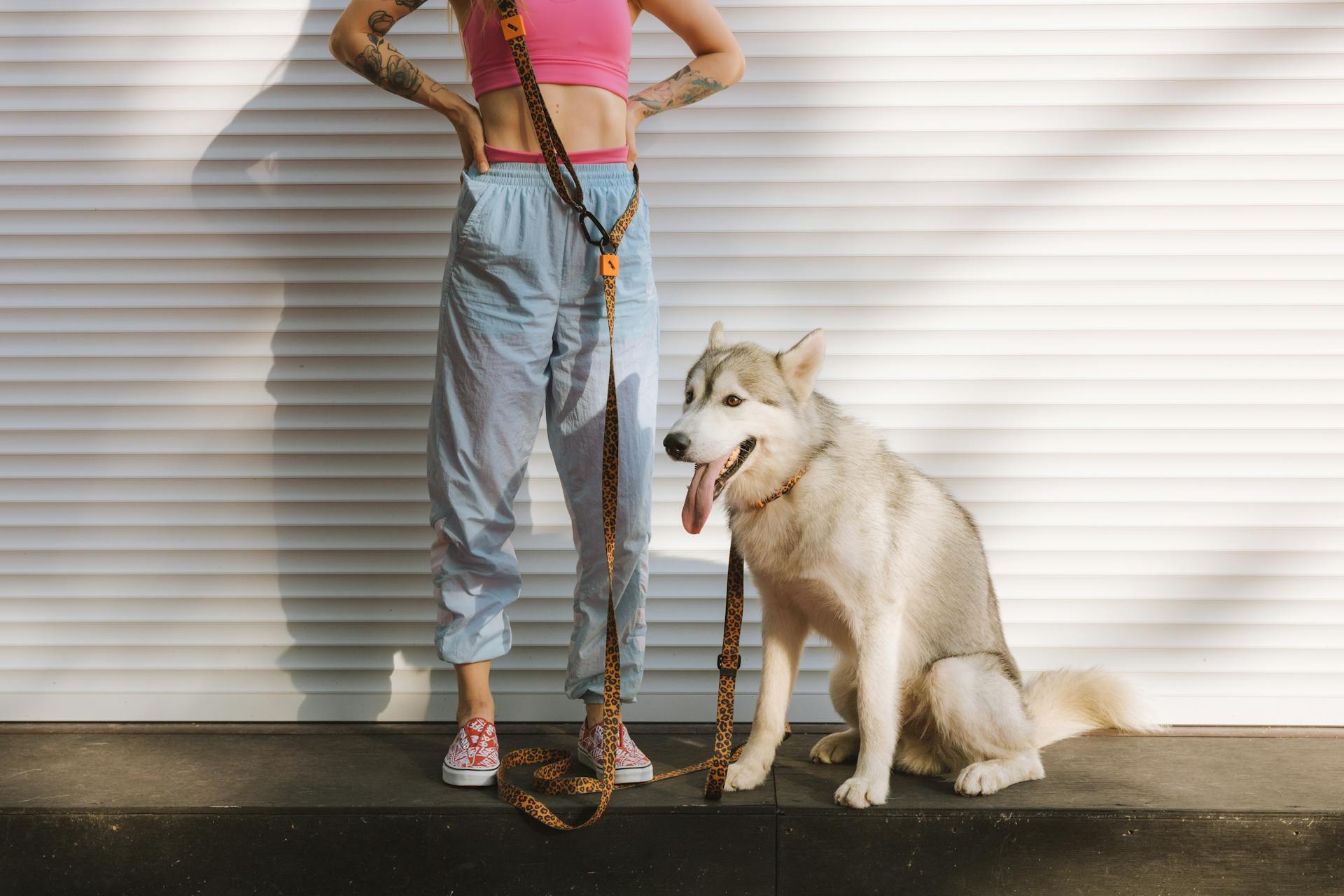
After a spay surgery, your female dog will need some TLC to ensure a smooth and comfortable recovery. Monitor her for signs of pain, such as whining, panting, or restlessness.
The first 24 to 48 hours post-surgery are crucial, so keep a close eye on her. She may be more lethargic than usual and may not want to eat or drink much.
For another approach, see: How Long Is a Spay Surgery for Female Dog
Pre-Surgery Preparation
Before your female dog undergoes spay surgery, it's essential to prepare her for the procedure.
Pre-surgery preparation typically begins 7-10 days prior to the surgery date.
Your veterinarian will likely recommend a blood test to ensure your dog's health and detect any underlying conditions that may affect the surgery.
Make sure your dog is up-to-date on her vaccinations, especially the rabies vaccination, which is often required by law.
It's also crucial to discuss any medications your dog is currently taking with your veterinarian, as some may need to be discontinued before the surgery.
In the days leading up to the surgery, ensure your dog has a balanced diet and plenty of fresh water to stay hydrated.
Avoid giving your dog any table scraps or fatty foods, as they can cause digestive issues and make the surgery more complicated.
Expand your knowledge: Taking Care of a Dog after Bloat Surgery
Immediate Post-Surgery Care
After your female dog's spay surgery, it's essential to keep her calm and quiet for the first 12 to 24 hours. She'll likely be a bit groggy and wobbly from the anesthesia, so make sure to keep a close eye on her.
Your vet will have medicated her for pain before sending her home, but you'll also receive additional pain meds for the next few days. Depending on the circumstances, you may also be sent home with anti-inflammatory medication and maybe even an antibiotic. The doctor will decide what's best for your dog.
To prevent your dog from bothering the surgery spot, you can use a cone to keep her from reaching the area. This will help keep it safe and clean.
A different take: Female Dog Uti Treatment at Home
One Day Post-Surgery
Your pet is likely to be uncomfortable, irritable, groggy, and even aggressive due to the medications they received.
Keep other animals, children, and strangers away from your pet on the first day home to prevent any stress or potential harm.
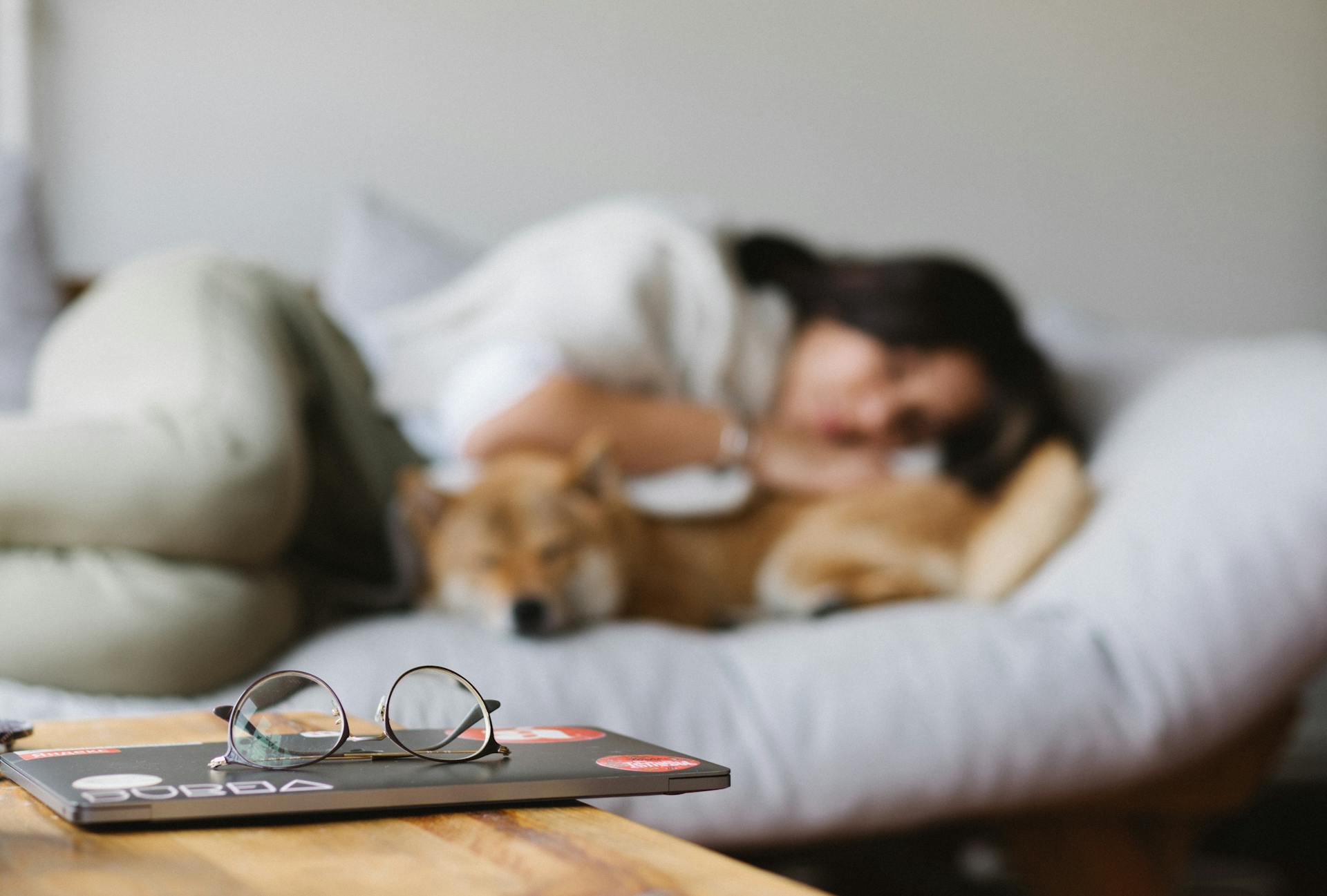
Confine your pet in a small space, meaning no free-roaming or access to human beds, furniture, and stairs.
You can offer small amounts of food and water, but pets are generally nauseous or not hungry for 24 to 48 hours after surgery.
A small portion of pet CBD, usually a quarter of their usual daily portion, can be offered at least two hours apart if they can keep the first portion down.
Do not change your dog's regular diet unless your vet recommends it.
Your pet needs to rest and recover, so keep them calm and quiet, and avoid strenuous activities.
Keep an eye on your pet's behavior and watch for any signs of distress or discomfort.
A fresh viewpoint: Small Female Dog
Pet Arrival Guide
Your pet is finally home, and it's time to provide the extra love and attention they need to recover well.
Give your pet some quiet time to rest and relax. They'll need it after surgery.
Monitor the surgery area closely, checking it every few times a day to ensure it's healing correctly. Take your dog back to the vet for a checkup if you notice any discharge, opened sutures, or redness.
It's normal for your pet to lick the surgery area, but if they can't leave it alone, you may need to get an Elizabethan collar (cone) for larger dogs or a soft collar for smaller pups.
A cone can be a bit unappealing to some pets, but an inflatable collar is a great alternative. It's softer and less intrusive than a cone, and it won't hinder your pet's natural behaviors like eating, drinking, and sleeping comfortably.
Female pets that were spayed while in heat should be kept away from male animals that could still be attracted to her.
Post-Surgery Care
After your dog's surgery, it's essential to provide them with a safe and comfortable environment to recover. Keep other animals, children, and strangers away from your pet on the first day home.
A different take: Dog Names Female Start with S
Handling your dog with care is crucial, especially if they're small or have received medication that may make them uncomfortable or irritable. Be gentle when lifting them, and avoid picking them up if possible.
You'll need to confine your pet in a small space, such as a crate or room, to prevent them from roaming free or jumping on furniture. This will help prevent accidents and keep them safe.
Offer small amounts of food and water, and a small portion of pet CBD if recommended by your vet. Avoid changing your dog's regular diet unless instructed by your veterinarian.
As your dog recovers, they may experience nausea or lack of appetite for 24 to 48 hours after surgery. Don't worry, this is normal, and they'll start to feel better soon.
Keep an eye on your dog's surgery area, checking it every few times a day to ensure it's healing correctly. If you notice any discharge, opening of the sutures, or redness, take your dog back to the vet for a checkup.
You can expect some post-surgery side effects, such as razor burns or swelling around the incision site, but these will resolve themselves. If your dog can't leave the surgery site alone, you may need to get an Elizabethan collar or soft collar to prevent them from licking or chewing the area.
Follow your vet's post-surgery instructions carefully, and don't hesitate to contact your veterinary clinic if you have any concerns or questions. With proper care and attention, your dog will be back to their normal self in no time.
For another approach, see: Does Getting a Female Dog Fixed Calm Her down
Wound Care and Monitoring
Protect your dog's surgical site by preventing them from scratching and licking the area. You can use a cone, also known as an Elizabethan collar, to keep them from reaching the spot.
Monitoring your dog's surgical site is crucial to ensure a smooth recovery. Take photographs of the wound daily to track any changes.
A normal healing wound should remain soft, with a normal skin color. Look out for signs of complications, such as hard or soft swelling, bleeding, discharge, or unpleasant smells from the surgical site.
Here are some signs to watch out for and contact your vet immediately if you notice:
- Hard or soft swelling
- Bleeding
- Discharge
- Unpleasant smells from the surgical site
Keep the incision site clean and dry to prevent infection. Avoid bathing your dog for at least ten days post-surgery, and use damp cloths or pet-friendly wipes to clean any soiled areas.
Monitor your dog's incision site several times a day, looking for signs of complications such as excessive bleeding, drainage, or swelling. Notify your vet immediately if you notice any changes.
Your vet may recommend an Elizabethan collar to prevent your dog from licking or gnawing at the incision. This is usually for about 10 days, and it's essential to follow their advice to ensure a smooth recovery.
Curious to learn more? Check out: Hemangiosarcoma Last Days
Recovering After Surgery
Rest is key for your furry friend after surgery, just like it is for humans. She'll need to limit her activity for the first few days to allow her body to heal.
You'll want to keep her calm and quiet, maybe even having some lazy days where you just watch TV together. This will help her feel more comfortable and relaxed.
Some activities to avoid during the recovery period include jumping onto or off the couch, bed, or stairs, as well as running or playing with other dogs or pets. You should also avoid bathing her for at least 10 days and keep her on a short leash during walks.
Here are some specific things to avoid during the recovery period:
- Jumping onto or off the couch.
- Jumping onto or off the bed.
- Running up or down the stairs.
- Activity that will put a strain on the incision.
- Playing with other dogs or pets for up to two weeks.
- Running off-leash.
- Extendable leashes.
- Bathing the dog for at least 10 days.
You should also be aware of the risks of infection and take steps to prevent it, such as keeping her incision clean and dry, and avoiding exposure to bacteria and parasites in the yard.
In terms of walks, it's best to keep them short and on a leash, especially in areas where other dogs may have relieved themselves. This will help prevent any bacteria or parasites from coming into contact with her wound.
It's also a good idea to keep your dog indoors as much as possible, especially in the first few days after surgery, to prevent any accidents or injuries.
As for pain medication, your vet will have already medicated your dog before sending her home, and you'll receive additional medication to give her for the next few days. You may also be sent home with anti-inflammatory medication and an antibiotic, depending on the circumstances.
Remember to follow your vet's advice and contact them right away if you notice any signs of infection or if your dog is taking longer than expected to recover.
In the first few days after surgery, your dog will likely be a bit groggy and wobbly from the anesthesia, but this is a good thing - it means they're getting plenty of rest and quiet time, which is exactly what they need.
See what others are reading: Home Remedies for Rough Dog Paws
Post-Surgery Instructions
After your female dog's spay surgery, it's essential to follow the post-surgery instructions provided by your vet.
Avoid picking up smaller-sized dogs, as handling them could cause injury to their surgical site. If your dog finds comfort through cuddling, be careful when lifting them, and place a hand under their chest and gently scoop their backend up with your other hand.
On the first day home, keep other animals, children, and strangers away from your pet, and confine them in a small space to prevent any stress or injury. You can offer small amounts of food and water, and a small portion of pet CBD, usually a quarter of their usual daily portion, at least two hours apart.
Check the surgery area every few times a day to ensure it's healing correctly, and take your dog back to the vet for a checkup if you notice any discharge, the opening of the sutures, or redness. Licking of the area is expected, but if your dog can't leave the site alone, you may need to get an Elizabethan collar or a soft collar.
Suggestion: Pitbull Mix with Small Dog
Cats and dogs usually take about two weeks to recover from spay or neuter surgery, but your vet may recommend a follow-up appointment before allowing your animal to resume strenuous activity. Be sure to follow the post-op instructions provided by your vet and contact your veterinary clinic right away if your pet is taking longer than expected to recover.
Offer small, easily digestible meals to prevent digestive upset, and avoid rich or fatty foods that might upset your dog's stomach. Stick to a bland and easy-to-digest diet, and follow a regular feeding schedule to promote healing and provide comfort.
Your vet will provide specific post-surgery feeding guidelines, so be sure to follow their instructions. You can also use a cone to prevent your dog from bothering the surgery spot.
Follow Up Care
After a spay surgery, your female dog needs careful follow-up care to ensure a smooth recovery. Keeping her calm is crucial, especially if she's a high-energy dog.
Giving your dog plenty of rest is essential. Your vet's post-surgery instructions should be followed closely to prevent any complications.
Provide a quiet and comfortable space for your dog to recover. This might seem like a challenge if she's used to being active, but it's vital for her recovery.
Readers also liked: Recovery Time for Spaying a Female Dog
Sources
- https://www.prouddogmom.com/spaying-dog/
- https://www.animalfriends.co.uk/dog/dog-advice/dog-maintenance-and-safety/spaying-neutering-aftercare-guide-for-dogs/
- https://petreleaf.com/blog/a-guide-to-caring-for-your-dog-post-spay-or-neuter
- https://www.northgateveterinary.com/site/blog/2022/04/30/post-op-care-spay-neuter
- https://parliamentanimalhospital.ca/how-to-care-for-your-dog-after-a-spay/
Featured Images: pexels.com
